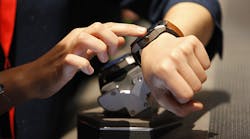BERLIN — Smartwatches were hyped as the next big thing after smartphones but tech giants have struggled to put one on every wrist and Apple’s latest offering, aimed mainly at fitness enthusiasts, is unlikely to change that, analysts say.
Three years after smartwatches were launched to great fanfare, sales have disappointed as consumers have failed to get excited about the possibility of checking calls, texts and emails on the go without ever getting their phones out. Grumbles about bulky design and short battery life haven’t helped either.
Global smartwatch shipments soared eight-fold — from 5 million units in 2014 to 40.3 million in 2015, according to estimates by Gartner consultancy. But the pace of growth has since slowed, with 60.4 million watches to be shipped this year and 66.3 million in 2017.
Industry players, however, argue that there is still a lot to play for, and market leader Apple led the way on Wednesday when it launched its second-generation Apple Watch. Designed to be waterproof and with a built-in GPS for runners and cyclists, the device is most likely to appeal to sports lovers who want to track their workouts without carrying their phones.
Apple also announced an edition of the watch that was developed with Nike, which chief operating officer Jeff Williams called “a watch designed with runners in mind”.
With its strong emphasis on using the Apple Watch Series 2 to support a healthy lifestyle, Apple has clearly chosen to focus on the booming fitness sector rather than target mainstream consumers, CCS Insight’s George Jijiashvili said.
“It’s still not something that will make an average consumer run out and buy one,” the wearables analyst told AFP.
IHS insight analyst Ian Fogg said Apple had made some sensible upgrades but said the new watch was unlikely to make big waves: “For now, the increased fitness capabilities and Nike partnerships will keep the Apple Watch business moving, without creating a break-out new product category success for Apple as the original iPhone was nine years ago.”
He argued that manufacturers needed to make several technological advancements in order to appeal to a broader market than just tech geeks. “I still think there’s a tremendous opportunity for it, but the technology needs to become better, to enable multi-day battery life, to enable ubiquitous always-on screens, to enable the size of the devices to become smaller.”
The problems are all related — the devices are chunky because the screen technology and battery needed to power it requires a watch of a certain size. Sony Mobile France director-general Jean-Raoul de Gelis agreed that the sector can only push into the mainstream if “real innovations” are made.
“A smartwatch that has to be recharged every day quickly becomes irritating for the user,” he said. “It’s not a dying market, but it’s a market that has to make more progress on technological areas,” de Gelis told AFP on the sidelines of Berlin’s IFA tech fair, which ended on Wednesday.
One of the first entrants into the smartphone market, South Korean giant Samsung, said it was seeking to tackle some of those problems by teaming up with a designer from the traditional watch industry — Swiss, no less. Its new Gear S3, its third generation smartwatch, has a round face and offers battery life of three to four days. Nevertheless, it remains a big watch.
Guillaume Berlemont, marketing director for mobile devices at Samsung France, said the company had worked with a designer from Swiss watchmaker Hublot, in order “to respond to the expectations of those who want a watch”. Samsung does not see smartwatches becoming ersatz smartphones. Rather, it is seeking to replace conventional timepieces.
“Traditional watchmakers are trying to introduce more and more electronics into their classic watches, and we are bringing out connected watches closer to the classic watch format,” he said. “We believe that within two years, the market will just simply become the watch market.”
Jijiashvili agreed and said consumers would eventually fall in love with “smartwatches that look like traditional watches with some smartness imbedded
“That area will see mass market appeal.”
By Marie Julien and Hui Min Neo
Copyright Agence France-Presse, 2016




